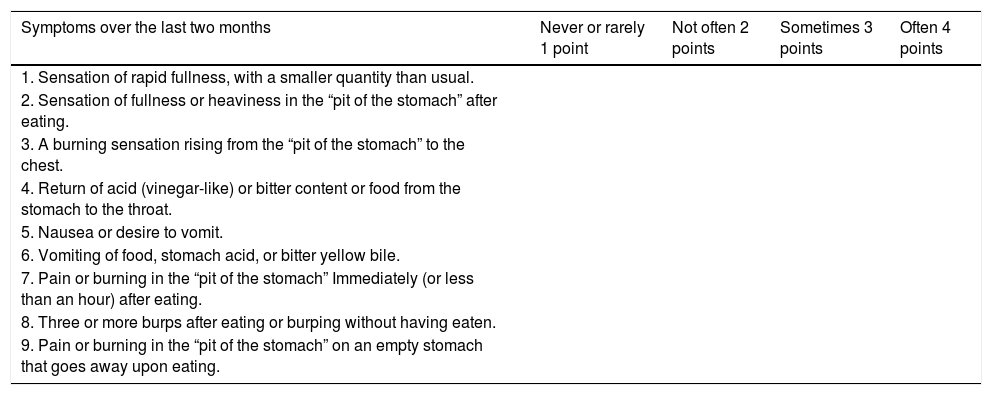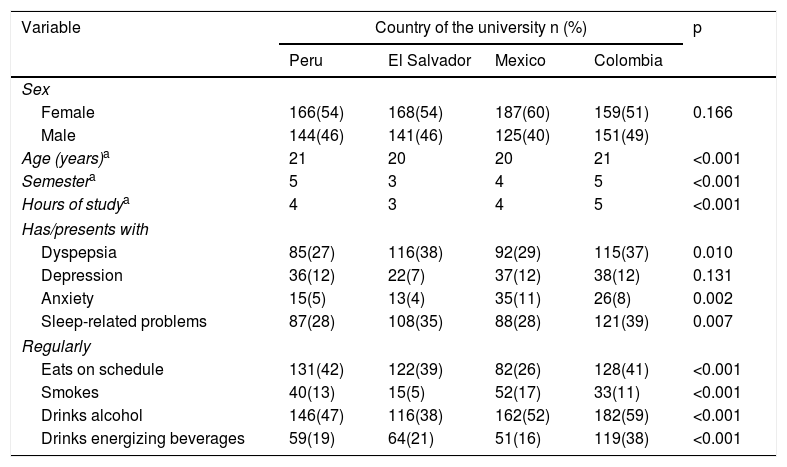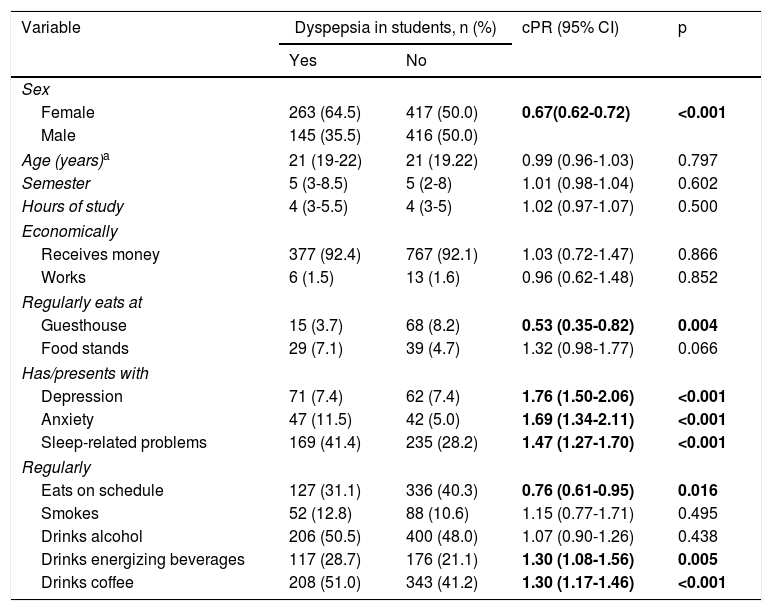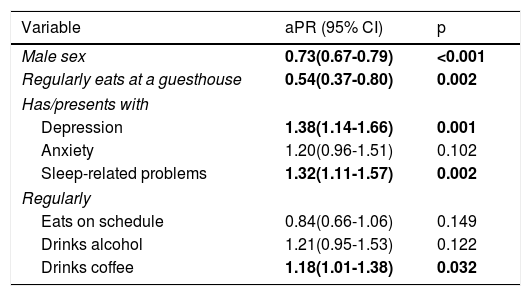Dyspepsia is a multifactorial disease that can involve alcohol, tobacco, or nonsteroidal anti-inflammatory drug use, as well as lifestyle, diet, socioeconomic elements, or psychologic factors. The aim of the present article was to establish the frequency of uninvestigated dyspepsia and determine its associated factors in students at 4 Latin American schools of medicine.
Materials and methodsA cross-sectional, analytic study was conducted, in which a survey made up of closed-ended questions was applied at just one point in time. The association between the variables was then analyzed. A new questionnaire for the diagnosis of dyspepsia was one of the tests utilized to diagnose uninvestigated dyspepsia. Generalized linear models were used for the bivariate and multivariate analyses, employing the Poisson model with the log link function, obtaining crude prevalence ratios, adjusted prevalence ratios, and their 95% confidence intervals.
ResultsOf the 1,241 individuals surveyed, 54% (841) were females and the median age was 21 years (range: 19-23 years). Prevalence of uninvestigated dyspepsia was 46%. The factors that had a direct association with dyspepsia were: depression, difficulty sleeping, and coffee consumption. On the contrary, eating regularly in a boarding house and the male sex had an inverse association.
ConclusionsUninvestigated dyspepsia frequency was high in students at 4 Latin American schools. Depression, difficulty sleeping, and steady coffee drinking were factors directly associated with dyspepsia, whereas male sex and eating out at regular hours were factors with a reverse association. Therefore, we recommend that universities implement early detection programs for this highly preventable pathology.
La dispepsia es una enfermedad de naturaleza multifactorial, ya que podrían intervenir distintos factores, como el consumo de alcohol, tabaco o antiinflamatorios no esteroideos, el estilo de vida, factores dietéticos, socioeconómicos y psicológicos. El objetivo es establecer la frecuencia y determinar los factores asociados con dispepsia no investigada en estudiantes de 4 facultades de medicina de Latinoamérica.
Materiales y métodosEstudio transversal analítico, aplicando una encuesta cerrada en un solo periodo, analizando posteriormente la asociación entre las variables. Se usó el test A new questionnaire for the diagnosis of dyspepsia para el diagnóstico de dispepsia no investigada, entre otras pruebas. Para el análisis bivariado y multivariado se utilizaron los modelos lineales generalizados, usando la familia Poisson con función de enlace log, obteniendo razones de prevalencia crudas, ajustadas y sus intervalos de confianza al 95%.
ResultadosDe los 1,241 encuestados, el 54% (841) fueron del sexo femenino y la mediana de edad fue de 21 años (rango 19-23 años). La prevalencia de dispepsia no investigada fue del 46%. Los factores que tuvieron una asociación directa a la dispepsia fueron: depresión, problemas para conciliar el sueño y el consumo de café. Por el contrario, comer regularmente en una pensión y el sexo masculino tuvieron una asociación inversa.
ConclusionesLa frecuencia de dispepsia no investigada fue alta en estudiantes de 4 escuelas latinoamericanas. La depresión, la dificultad para dormir y el consumo constante de café fueron factores que se asociaron directamente con la dispepsia, mientras que el sexo masculino y el comer regularmente en una pensión fueron factores con una asociación inversa. Por lo tanto, recomendamos que las universidades implementen programas de detección temprana para esta patología altamente prevenible.
Dyspepsia is a syndrome made up of a series of chronic and recurrent disorders of the upper gastrointestinal tract that is characterized by the sensation of fullness, burping, epigastric discomfort, and nausea, among other symptoms.1 It is considered a multifactorial disease,2 and some of its most associated factors are alcohol, tobacco, and nonsteroidal anti-inflammatory drug consumption, lifestyle, diet, and socioeconomic and psychologic factors.3–6 The most widespread categorization of dyspepsia is into 3 types: organic dyspepsia (in which an organic or metabolic cause has been found), functional dyspepsia (investigated dyspepsia, in which no cause has been found), and uninvestigated dyspepsia. Peptic ulcer disease, Helicobacter pylori infection, and gastric cancer are the most outstanding organic causes,7 whereas visceral hypersensitivity, emptying disorders, and gastric accommodation are the most outstanding functional dyspepsia mechanisms.8 The estimated worldwide prevalence of uninvestigated dyspepsia varies in different populations from 11-29%,4,9 reaching high values that correspond to dyspepsia presentation in 2 out of every 3 subjects.10 The statistical data on that pathology are insufficient in the South American countries. A prevalence of 38% associated with eating habits was reported in a study conducted on a jungle population in Peru.4,11
Some populations demonstrate a higher prevalence of dyspepsia, such as those that suffer from high levels of stress,12 as is the case with medical students, a population that puts great importance on its education. A high level of academic pressure on the student is inherent in a professional career in medicine, constantly exposing him or her to biopsychosocial factors that could be associated with having gastrointestinal diseases.13,14 The study of dyspepsia in undergraduate students has shown a high prevalence in different populations. A prevalence of 14% was found at an Austrian medical school,3 whereas it was 25% at a Brazilian university.4 In addition, factors associated with dyspepsia have been identified in undergraduate students studying health sciences. Some degree of stress has been detected in 53% of medical students, and it is higher during the first years of study.15,16
Given that dyspepsia is multifactorial and greatly influenced by biopsychosocial factors, our study aim was to establish the frequency of uninvestigated dyspepsia and determine the factors associated with the presence of that syndrome in students from 4 medical schools in Latin America.
Materials and methodsStudy design and populationAn analytic, cross-sectional study was conducted, in which a closed survey was applied within a single time frame, between February and May 2015.
The study population was made up of students from 4 medical schools in Latin America: the Universidad Autónoma del Estado de México (Toluca, Mexico); the Universidad Tecnológica de Pereira (Pereira, Colombia); the Universidad “José Matías Delgado” (San Salvador, El Salvador); and the Universidad Católica de Santa María (Arequipa, Peru). The minimum sample size was calculated at 282 students per site. The difference in dyspepsia percentages was calculated according to 3 of the most important study variables. That was done utilizing an 80% study power and a 95% confidence interval. The survey in a single population was carried out using the EPIDAT 4.0 program. Ten percent was added to the sample value to account for possible losses at the time of the survey, resulting in a sample of 312 students per school site. Random stratified sampling was performed (considering each study year as a stratum).
All the students enrolled in the 2015-I cycle that were in their penultimate year of study (excepting interns) were included. Students that did not wish to participate were excluded, as well as students that did not regularly attend classes (less than 1% of those excluded). They were excluded due to the multicausality of student absenteeism, especially the academic, personal, and illness-related reasons of different types and levels of importance, and also due to difficult follow-up and data collection in that type of student. Likewise, incomplete tests, those that had repetitive patterns, and other aspects impeding their analysis were eliminated.
Instruments and variablesA self-administered survey was created that included sociodemographic variables (age, sex, civil status, paternity, economic independence), academic variables (year of entrance into medical school, current academic semester, course/subject failure, number of hours spent studying outside of class), anthropometric variables (body mass index), and the variables measured through validated tests in Spanish: dyspepsia, evaluated through the questionnaire A new questionnaire for the diagnosis of dyspepsia,17 which was chosen because it had been validated in a South American population, with 95% sensitivity and 100% specificity, and was used in a study on medical students with a similar aim conducted in one of the countries of the present study school sites;18 anxiety and depression, through the Zung self-assessment scales,19,20 with 95% sensitivity and 67% specificity, and an internal consistency of 0.85 measured using Cronbach's alpha; smoking, through the Fargerstrom scale validated for Spanish21 with 69% sensitivity, 71% specificity, and an internal consistency of 0.80, measured using Cronbach's alpha; and alcohol consumption, through the CAGE scale validated for Spanish,22 with 58% sensitivity and 87% specificity.
The dependent variable was the diagnosis of uninvestigated dyspepsia, measured using the abovementioned scale (Table 1). The questionnaire contains 9 items with symptom frequency-related answers. Answers were considered positive with 3 or more points (moderately or highly positive).
Dyspepsia diagnostic scale validated for Spanish.
| Symptoms over the last two months | Never or rarely 1 point | Not often 2 points | Sometimes 3 points | Often 4 points |
|---|---|---|---|---|
| 1. Sensation of rapid fullness, with a smaller quantity than usual. | ||||
| 2. Sensation of fullness or heaviness in the “pit of the stomach” after eating. | ||||
| 3. A burning sensation rising from the “pit of the stomach” to the chest. | ||||
| 4. Return of acid (vinegar-like) or bitter content or food from the stomach to the throat. | ||||
| 5. Nausea or desire to vomit. | ||||
| 6. Vomiting of food, stomach acid, or bitter yellow bile. | ||||
| 7. Pain or burning in the “pit of the stomach” Immediately (or less than an hour) after eating. | ||||
| 8. Three or more burps after eating or burping without having eaten. | ||||
| 9. Pain or burning in the “pit of the stomach” on an empty stomach that goes away upon eating. |
Source: A new questionnaire for the diagnosis of dyspepsia17
A research project was designed based on a survey that contained the abovementioned tests. The project was then reviewed and approved by an ethics committee. Permission was requested and granted at each university site to apply the questionnaire during the stipulated time period, once the project had been explained to the students and they agreed to participate. The survey responses were placed in a general database, and data quality control was performed by the statistician of the research group.
Data analysisThe database was created in the Excel 2010 program and the data were analyzed using Stata 11.1 software. The numerical variables were evaluated through a descriptive analysis to determine their normality, using the Shapiro-Wilk test to describe the mean and standard deviation. The categorical variables were analyzed using frequencies and percentages. They were crossed for the bivariate and multivariate statistical analyses using general linear models with the Poisson family, the log link function, and robust models, adjusting each university as a cluster, given that each university could have different realities. Crude prevalence ratios (cPRs) and adjusted prevalence ratios (aPRs), along with their 95% confidence intervals (95%CIs), were obtained. Statistical significance was set at a p < 0.05.
Research ethicsData confidentiality was respected, and the international ethics recommendations were followed. The study protocol was approved by the ethics committee of the Hospital Nacional Docente Madre Niño San Bartolomé (OFFICIAL LETTER No.: 243-DG-OADI-No. 15007-HONADOMANI-SB-2015).
ResultsOf the 1,241 medical students surveyed, 54.8% (680) were female and the median student age was 21 years (range: 19-22 years). The sexes of the students surveyed were statistically similar, whereas there were differences in the other variables, depending on the participating university. The main descriptive results according to each university site are shown in Table 2.
The socioeducational characteristics of the study participants according to the country of the university.
| Variable | Country of the university n (%) | p | |||
|---|---|---|---|---|---|
| Peru | El Salvador | Mexico | Colombia | ||
| Sex | |||||
| Female | 166(54) | 168(54) | 187(60) | 159(51) | 0.166 |
| Male | 144(46) | 141(46) | 125(40) | 151(49) | |
| Age (years)a | 21 | 20 | 20 | 21 | <0.001 |
| Semestera | 5 | 3 | 4 | 5 | <0.001 |
| Hours of studya | 4 | 3 | 4 | 5 | <0.001 |
| Has/presents with | |||||
| Dyspepsia | 85(27) | 116(38) | 92(29) | 115(37) | 0.010 |
| Depression | 36(12) | 22(7) | 37(12) | 38(12) | 0.131 |
| Anxiety | 15(5) | 13(4) | 35(11) | 26(8) | 0.002 |
| Sleep-related problems | 87(28) | 108(35) | 88(28) | 121(39) | 0.007 |
| Regularly | |||||
| Eats on schedule | 131(42) | 122(39) | 82(26) | 128(41) | <0.001 |
| Smokes | 40(13) | 15(5) | 52(17) | 33(11) | <0.001 |
| Drinks alcohol | 146(47) | 116(38) | 162(52) | 182(59) | <0.001 |
| Drinks energizing beverages | 59(19) | 64(21) | 51(16) | 119(38) | <0.001 |
The bivariate analysis produced a strong association between uninvestigated dyspepsia and sex (p < 0.001), eating regularly at a guesthouse (p = 0.004), depression (p < 0.001), anxiety (p < 0.001), and sleep-related problems (p < 0.001). Likewise, dyspepsia was associated with eating at regular hours (p = 0.016), drinking energizing beverages (p = 0.005), and drinking coffee on a regular basis (p < 0.001) (Table 3).
Bivariate analysis of dyspepsia according to the socioeducational and hygiene variables of medical students at 4 Latin American universities.
| Variable | Dyspepsia in students, n (%) | cPR (95% CI) | p | |
|---|---|---|---|---|
| Yes | No | |||
| Sex | ||||
| Female | 263 (64.5) | 417 (50.0) | 0.67(0.62-0.72) | <0.001 |
| Male | 145 (35.5) | 416 (50.0) | ||
| Age (years)a | 21 (19-22) | 21 (19.22) | 0.99 (0.96-1.03) | 0.797 |
| Semester | 5 (3-8.5) | 5 (2-8) | 1.01 (0.98-1.04) | 0.602 |
| Hours of study | 4 (3-5.5) | 4 (3-5) | 1.02 (0.97-1.07) | 0.500 |
| Economically | ||||
| Receives money | 377 (92.4) | 767 (92.1) | 1.03 (0.72-1.47) | 0.866 |
| Works | 6 (1.5) | 13 (1.6) | 0.96 (0.62-1.48) | 0.852 |
| Regularly eats at | ||||
| Guesthouse | 15 (3.7) | 68 (8.2) | 0.53 (0.35-0.82) | 0.004 |
| Food stands | 29 (7.1) | 39 (4.7) | 1.32 (0.98-1.77) | 0.066 |
| Has/presents with | ||||
| Depression | 71 (7.4) | 62 (7.4) | 1.76 (1.50-2.06) | <0.001 |
| Anxiety | 47 (11.5) | 42 (5.0) | 1.69 (1.34-2.11) | <0.001 |
| Sleep-related problems | 169 (41.4) | 235 (28.2) | 1.47 (1.27-1.70) | <0.001 |
| Regularly | ||||
| Eats on schedule | 127 (31.1) | 336 (40.3) | 0.76 (0.61-0.95) | 0.016 |
| Smokes | 52 (12.8) | 88 (10.6) | 1.15 (0.77-1.71) | 0.495 |
| Drinks alcohol | 206 (50.5) | 400 (48.0) | 1.07 (0.90-1.26) | 0.438 |
| Drinks energizing beverages | 117 (28.7) | 176 (21.1) | 1.30 (1.08-1.56) | 0.005 |
| Drinks coffee | 208 (51.0) | 343 (41.2) | 1.30 (1.17-1.46) | <0.001 |
cPR: crude prevalence ratio; 95%CI: 95% confidence interval; p value obtained through generalized linear models, with the Poisson family, log link function, robust models, and adjusted for each university as a cluster. The data in bold numbers are those with statistical significance.
The multivariate analysis showed that the frequency of presenting with uninvestigated dyspepsia increased in students with depression (aPR: 1.38; 95% CI: 1.14-1.66; p = 0.001), in those that had sleep-related problems (aPR: 1.32; 95% CI: 1.11-1.57; p = 0.002) and in students that drank coffee on a regular basis (aPR: 1.18; 95% CI: 1.01-1.38; p = 0.032), whereas the frequency of presenting with uninvestigated dyspepsia decreased in male students (aPR: 0.73; 95% CI: 0.67-0.79; p < 0.001) and in students that ate at a guesthouse on a regular basis (aPR: 0.54; 95%CI: 0.37-0.80; p=0.002). All those associations were adjusted by anxiety, eating at regular hours, and drinking alcohol on a regular basis (Table 4).
Multivariate analysis of dyspepsia according to the significant variables in medical students at 4 Latin American universities.
| Variable | aPR (95% CI) | p |
|---|---|---|
| Male sex | 0.73(0.67-0.79) | <0.001 |
| Regularly eats at a guesthouse | 0.54(0.37-0.80) | 0.002 |
| Has/presents with | ||
| Depression | 1.38(1.14-1.66) | 0.001 |
| Anxiety | 1.20(0.96-1.51) | 0.102 |
| Sleep-related problems | 1.32(1.11-1.57) | 0.002 |
| Regularly | ||
| Eats on schedule | 0.84(0.66-1.06) | 0.149 |
| Drinks alcohol | 1.21(0.95-1.53) | 0.122 |
| Drinks coffee | 1.18(1.01-1.38) | 0.032 |
aPR: adjusted prevalence ratio; 95%CI: 95% confidence interval; p value obtained through generalized linear models, with the Poisson family, log link function, robust models, and adjusted for each university as a cluster. The data in bold numbers are those with statistical significance.
Studies on the present topic are important, given the high frequency of uninvestigated dyspepsia worldwide, keeping in mind all the difficulties involved in the adequate investigation of that pathology and ruling out an organic cause. In addition, there is no specific treatment for multifactorial dyspepsia, also known as functional dyspepsia,23 making it essential to find the factors that can be associated with its appearance and development.24,25 That would provide the possibility of decreasing the risks for presenting with dyspepsia and thus reduce the socioeconomic impact of the disease on the general population that results from numerous medical consultations, absenteeism, and reduced work and/or academic performance. All those factors are known to derive from a broad symptomatic spectrum that often begins at an early age, especially in developing countries,26 and could signify a risk for the future development of dyspepsia and other gastric diseases.
The frequency of uninvestigated dyspepsia in the population surveyed was very high, representing almost half of the students analyzed. That coincides with the results of a study conducted on a university population studying health sciences, in which 44.4% of the population had dyspepsia.27 However, those percentages were much higher than the results found in other Latin American student populations. In a study conducted at 8 schools of medicine in Peru, one out of every 4 medical students presented with dyspepsia.18 Likewise, in a study carried out in Nicaragua, the prevalence of uninvestigated dyspepsia was 26% in León and 36% in San Pedro del Norte.24 Additionally, even though they are realities not very similar to ours, a lower frequency of dyspepsia has been reported in studies from developed countries, such as England (34%), Denmark (28%), Norway (23%), and the United States (26%).11 That could be due to the different characteristics of the populations analyzed, given that the places with the lowest values were the results of a single country, reflecting a specific reality. Hence the importance of evaluating the situation of each reality with respect to dyspepsia, so that adequate measures are taken for each case.
One of the factors most highly associated with having uninvestigated dyspepsia in our study was coffee consumption. That coincides with a Colombian study in which 57% of the patients with dyspepsia had a high coffee intake.12 Likewise, Mahadeva and Goh stated that coffee consumption influenced having upper gastrointestinal symptomatology.4 That could be attributed to the action caffeine has on the organism, without ignoring the greater frequency of harmful habits that students of health sciences are exposed to.
Another strong inverse relation to dyspepsia was eating in the same place, called a guesthouse in the countries of the students surveyed, in which there is a more stable meal schedule, compared with other types of places to eat that students frequent. Other studies also reported that adequate eating, that is to say, eating at regular intervals, eating slowly and chewing the food well, was a protective factor, favoring the gastric processing of food and improved gastric emptying.28
In our study, we found that the students with depression had a greater association with dyspepsia presentation, which was similar to that reported in separate studies by El-Serag9 and Da Silva et al.29 They found a relation between psychologic factors and dyspepsia, lending evidence to the involvement of psychosocial stress, negative emotions, depressive symptoms, psychopathologic disorders, and certain personality traits. Due to the multifactorial nature of dyspepsia, it is necessary to find the associated factors that can aid in its intervention, thus reducing its effects on the gastrointestinal tract and other organs, as well as the psychologic effects, the consequences of which, in the case of students, lower academic performance. The association between dyspepsia and depression should be thoroughly evaluated, given that depression is increasingly common in university students, as was reported in a study conducted in several regions of Peru.30
Finally, we found a lower frequency of dyspepsia in males, concurring with that reported by Vargas et al. In their study conducted in Peru, they found that the frequency of dyspepsia was 25% lower in males (prevalence ratio of that study: 0.75, 95% CI: 0.64-0.87),18 which should be taken into account for creating individualized strategies according to the sex of the student.
Among the limitations of the present study were: not being able to have a clinical interview with each of the students surveyed or for them to undergo endoscopy or H. pylori screening. In addition, students with alarm signs and symptoms, those with chronic diseases, with a history of esophageal-gastric surgery, and chronic users of drugs that could increase or mask symptoms (nonsteroidal anti-inflammatory drugs or proton pump inhibitors) were not excluded, making it impossible to distinguish between functional dyspepsia and organic dyspepsia in the study, even though nonsteroidal anti-inflammatory drugs and proton pump inhibitor use was evaluated, and therefore we only spoke of uninvestigated dyspepsia. Another limitation was not being able to include student populations other than that of medical students, because not all the university faculties permitted access to their official enrollment lists. Nevertheless, by being a multicenter study with an adequate sample size, it serves as a first report supplying data for future investigations.
In conclusion, a high frequency of uninvestigated dyspepsia was found in the students from 4 Latin American schools of medicine. Depression, sleep-related problems, and coffee consumption on a regular basis were factors directly associated with dyspepsia, whereas male sex and eating at the same place (guesthouse) were factors inversely associated with dyspepsia.
Studies on other student populations should be carried out that investigate other biopsychosocial factors to find relations that can be extrapolated and to motivate future studies that can enrich preventive measures to improve lifestyles in university populations.
Ethical disclosuresProtection of human and animal subjectsThe authors declare that no experiments were performed on humans or animals for this investigation.
Confidentiality of dataThe authors declare that they have adhered to the protocols of their centre of work on patient data publication.
Right to privacy and informed consentThe authors declare that no patient data appear in this article.
Financial disclosureNo financial support was received in relation to this study/article.
Conflict of interestThe majority of the authors declare that they have studied at the university sites of the present analysis, but at no time did that influence the study or its results. The rest of the authors declare they have no conflict of interest.
The authors are especially grateful to Ernesto Paz Rojas, Christian Quiroz Navarro, Frank Carmen Gemin, Kris Rogel Aquino, Mariana Huaman Garcia, David Villamil, Mariet Betancourt, and Angel Lopez for their support in relation to data collection. The present article was prepared as part of the activities of the Research Group of the SOCEM (GIS), organized by the Medical Association of Research and Health Services. The manuscript was prepared by Lincolth Talledo-Ulfe, and met the participation requirements of the GIS, Lima, Peru.
Please cite this article as: Talledo-Ulfe L, Buitrago OD, Filorio Y, Casanova F, Campos L, Cortés F, et al. Factores asociados a dispepsia no investigada en estudiantes de 4 facultades de medicina de Latinoamérica: estudio multicéntrico. Revista Gastroenterol Méx. 2018;83:215–222.
See related content at DOI: https://doi.org/10.1016/j.rgmxen.2018.05.022, Carmona-Sánchez R. Editorial on the article «Factors associated with uninvestigated dyspepsia in students at 4 Latin American schools of medicine: A multicenter study». Rev Gastroenterol Méx. 2018;83:213–214.







